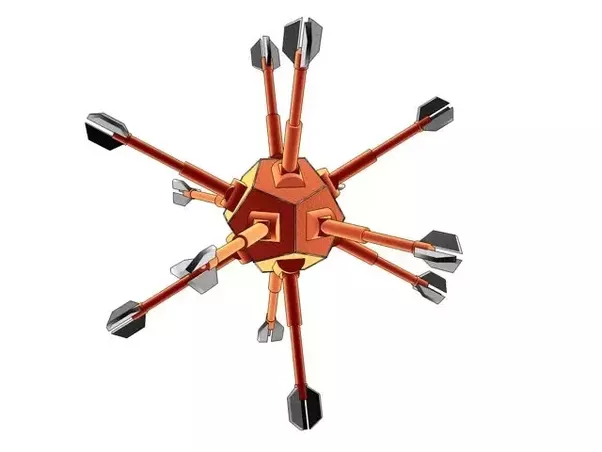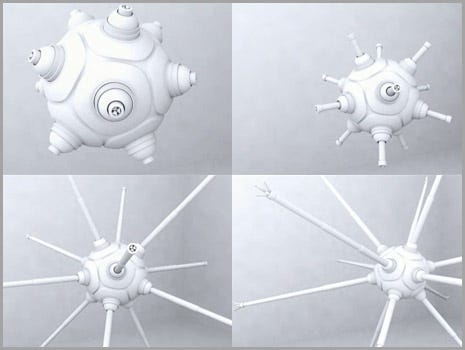The Future of Programmable Matter: Smart Dust and Utility Fog
Written on
The Vision of Programmable Matter
Envision countless minuscule robots, each no bigger than a grain of sand, collaborating as a coordinated swarm governed by a computer system. This idea forms the foundation of programmable matter, enabling the creation of buildings, tools, and various objects on demand — and potentially much more.
Utility Fog: A Conceptual Leap
In 1993, Josh Storrs Hall, inspired by Richard Feynman's vision of molecular nanotechnology and further developed by K. Eric Drexler, proposed an innovative idea. Instead of viewing nanotechnology as mere "miniature factories" producing intricate products, Hall imagined swarms of computer-controlled robots that could mimic larger objects in real-time. Each robot possesses twelve appendages, allowing it to create solid, liquid, or "fog" forms — essentially functioning as a micro-mechanical shapeshifter.

Anything you can conceive on a computer could be replicated in the physical world, including people, structures, furniture, and machinery. This technology would empower users to create, modify, or eliminate virtually anything at will and in mere seconds. Hall articulated this vision in an article for Kurzweil AI Net, stating:
“The Fog serves as an ongoing link between physical reality and virtual experiences. It acts as both a universal manipulator and a sensor, allowing for the intricate interaction with real objects in the Fog environment. Objects can be measured, analyzed, altered, or even reduced to microscopic parts for recycling purposes. Beyond augmenting individual capabilities, the Fog could serve as a foundational infrastructure for society, enabling a landscape devoid of permanent structures or traditional transport, resembling a park or even a fantastical city.”

While Hall's concept of Utility Fog is grand and innovative, it faces significant challenges regarding practical implementation. The question remains: how do we construct, energize, and command billions of tiny robots? After three decades, advancements suggest we may be nearing a solution.
Smart Dust: The Path Forward
If Utility Fog represents the goal, then Smart Dust provides the means to achieve it. Smart Dust refers to another swarm technology employing millions, or potentially billions, of microelectromechanical systems (MEMS) equipped with sensors to gather, process, store, and relay data about their surroundings.
As noted by Bernard Marr in Forbes, these compact devices are equipped with various sensors and communication tools to relay collected data back to a centralized system for analysis. He expresses optimism regarding its future applications:
“The ability of Smart Dust to gather comprehensive environmental data could transform numerous industries, enhancing safety, compliance, and productivity. It’s akin to exponentially expanding the Internet of Things.”
Corporate America shares this enthusiasm, with significant investments in Smart Dust by firms like General Electric, Cargill, IBM, and Cisco Systems, evolving from its military origins in 1991 by the RAND Corporation and DARPA into commercial applications. Although Smart Dust isn't fully realized yet, its emergence seems imminent; it was featured in the Gartner Hype Cycle of 2016, and Northrop Grumman has noted that advancements in 3D printing and materials science have dramatically lowered the costs and time needed to develop MEMS.
Biomedical Innovations
Smart Dust’s utility extends beyond external applications; it also holds promise for internal medical use. Research into MEMS is already in progress. In 2016, UC Berkeley researchers showcased the first implanted ultrasonic neural dust sensors, which can monitor and stimulate the nervous system from within, aiding in disease treatment and tracking electrical signals to provide insights on a patient’s health.
According to Today’s Medical Developments, for sensitive applications like medical implants, assessing the long-term reliability and potential failure of these devices is crucial before use. Despite inherent risks, the advantages of a mind-machine interface using Smart Dust could be transformative, offering novel treatment methods for nervous system disorders and facilitating internal repairs.
Virtual Beings: The Next Frontier
The integration of human and machine could occur through another avenue. By merging virtual telepresence technologies with nanotech utility fog, it may become feasible to project consciousness remotely. Imagine a hyper-realistic simulation where utility fog enables you to see, hear, and participate in distant events, interacting with your local body while also engaging with a remote environment through an artificial body composed of utility fog.
This technology could eliminate the necessity for business travel, allowing individuals to "teleport" to any location effortlessly. For instance, you could attend a meeting in China and return home within seconds, or equip the space station with utility fog, enabling astronauts to work remotely as virtual beings.
What if one doesn’t possess a "real" body? Transhumanists have long envisioned uploading consciousness into machines post-mortem. These individuals would effectively become the ultimate “ghosts in the machine,” existing through whole brain emulation but without corporeal forms. Utility fog could provide these "virtual" beings with bodies again, facilitating their interaction with the physical world.
Conclusion: A Pandora's Box
The potential of computer-controlled nanobot swarms composed of billions of tiny robots is immense, offering possibilities across communication, medicine, construction, and novel forms of remote interaction. This technology undoubtedly presents a Pandora's box, with safety being a primary concern for those venturing into this new technological realm. Nevertheless, the prospects of Smart Dust and Utility Fog are too significant to overlook, prompting both governmental and commercial entities to begin their exploration.
This video explores the concepts of Claytronics, smart dust, and utility fog, showcasing the future of shape-shifting technology.
This video provides insights into the applications of nanotecnology and utility fog, emphasizing their transformative potential.